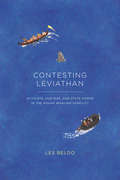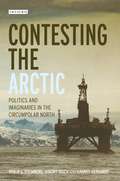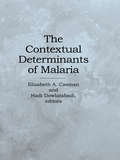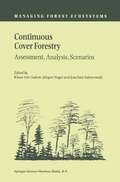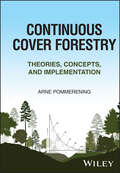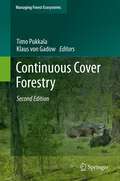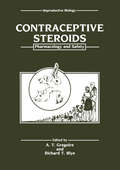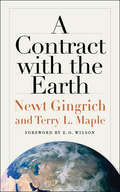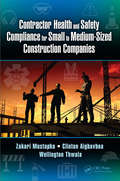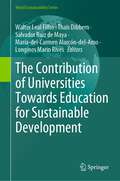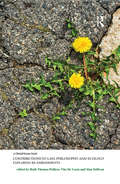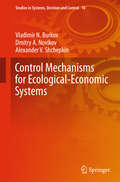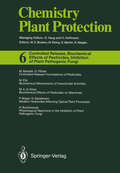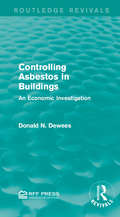- Table View
- List View
Contesting Leviathan: Activists, Hunters, and State Power in the Makah Whaling Conflict
by Les BeldoIn 1999, off the coast of the Pacific Northwest, the first gray whale in seven decades was killed by Makah whalers. The hunt marked the return of a centuries-old tradition and, predictably, set off a fierce political and environmental debate. Whalers from the Makah Indian Tribe and antiwhaling activists have clashed for over twenty years, with no end to this conflict in sight. In Contesting Leviathan, anthropologist Les Beldo describes the complex judicial and political climate for whale conservation in the United States, and the limits of the current framework in which whales are treated as “large fish” managed by the National Marine Fisheries Service. Emphasizing the moral dimension of the conflict between the Makah, the US government, and antiwhaling activists, Beldo brings to light the lived ethics of human-animal interaction, as well as how different groups claim to speak for the whale—the only silent party in this conflict. A timely and sensitive study of a complicated issue, this book calls into question anthropological expectations regarding who benefits from the exercise of state power in environmental conflicts, especially where indigenous groups are involved. Vividly told and rigorously argued, Contesting Leviathan will appeal to anthropologists, scholars of indigenous culture, animal activists, and any reader interested in the place of animals in contemporary life.
Contesting Leviathan: Activists, Hunters, and State Power in the Makah Whaling Conflict
by Les BeldoIn 1999, off the coast of the Pacific Northwest, the first gray whale in seven decades was killed by Makah whalers. The hunt marked the return of a centuries-old tradition and, predictably, set off a fierce political and environmental debate. Whalers from the Makah Indian Tribe and antiwhaling activists have clashed for over twenty years, with no end to this conflict in sight. In Contesting Leviathan, anthropologist Les Beldo describes the complex judicial and political climate for whale conservation in the United States, and the limits of the current framework in which whales are treated as “large fish” managed by the National Marine Fisheries Service. Emphasizing the moral dimension of the conflict between the Makah, the US government, and antiwhaling activists, Beldo brings to light the lived ethics of human-animal interaction, as well as how different groups claim to speak for the whale—the only silent party in this conflict. A timely and sensitive study of a complicated issue, this book calls into question anthropological expectations regarding who benefits from the exercise of state power in environmental conflicts, especially where indigenous groups are involved. Vividly told and rigorously argued, Contesting Leviathan will appeal to anthropologists, scholars of indigenous culture, animal activists, and any reader interested in the place of animals in contemporary life.
Contesting Leviathan: Activists, Hunters, and State Power in the Makah Whaling Conflict
by Les BeldoIn 1999, off the coast of the Pacific Northwest, the first gray whale in seven decades was killed by Makah whalers. The hunt marked the return of a centuries-old tradition and, predictably, set off a fierce political and environmental debate. Whalers from the Makah Indian Tribe and antiwhaling activists have clashed for over twenty years, with no end to this conflict in sight. In Contesting Leviathan, anthropologist Les Beldo describes the complex judicial and political climate for whale conservation in the United States, and the limits of the current framework in which whales are treated as “large fish” managed by the National Marine Fisheries Service. Emphasizing the moral dimension of the conflict between the Makah, the US government, and antiwhaling activists, Beldo brings to light the lived ethics of human-animal interaction, as well as how different groups claim to speak for the whale—the only silent party in this conflict. A timely and sensitive study of a complicated issue, this book calls into question anthropological expectations regarding who benefits from the exercise of state power in environmental conflicts, especially where indigenous groups are involved. Vividly told and rigorously argued, Contesting Leviathan will appeal to anthropologists, scholars of indigenous culture, animal activists, and any reader interested in the place of animals in contemporary life.
Contesting Leviathan: Activists, Hunters, and State Power in the Makah Whaling Conflict
by Les BeldoIn 1999, off the coast of the Pacific Northwest, the first gray whale in seven decades was killed by Makah whalers. The hunt marked the return of a centuries-old tradition and, predictably, set off a fierce political and environmental debate. Whalers from the Makah Indian Tribe and antiwhaling activists have clashed for over twenty years, with no end to this conflict in sight. In Contesting Leviathan, anthropologist Les Beldo describes the complex judicial and political climate for whale conservation in the United States, and the limits of the current framework in which whales are treated as “large fish” managed by the National Marine Fisheries Service. Emphasizing the moral dimension of the conflict between the Makah, the US government, and antiwhaling activists, Beldo brings to light the lived ethics of human-animal interaction, as well as how different groups claim to speak for the whale—the only silent party in this conflict. A timely and sensitive study of a complicated issue, this book calls into question anthropological expectations regarding who benefits from the exercise of state power in environmental conflicts, especially where indigenous groups are involved. Vividly told and rigorously argued, Contesting Leviathan will appeal to anthropologists, scholars of indigenous culture, animal activists, and any reader interested in the place of animals in contemporary life.
Contesting Leviathan: Activists, Hunters, and State Power in the Makah Whaling Conflict
by Les BeldoIn 1999, off the coast of the Pacific Northwest, the first gray whale in seven decades was killed by Makah whalers. The hunt marked the return of a centuries-old tradition and, predictably, set off a fierce political and environmental debate. Whalers from the Makah Indian Tribe and antiwhaling activists have clashed for over twenty years, with no end to this conflict in sight. In Contesting Leviathan, anthropologist Les Beldo describes the complex judicial and political climate for whale conservation in the United States, and the limits of the current framework in which whales are treated as “large fish” managed by the National Marine Fisheries Service. Emphasizing the moral dimension of the conflict between the Makah, the US government, and antiwhaling activists, Beldo brings to light the lived ethics of human-animal interaction, as well as how different groups claim to speak for the whale—the only silent party in this conflict. A timely and sensitive study of a complicated issue, this book calls into question anthropological expectations regarding who benefits from the exercise of state power in environmental conflicts, especially where indigenous groups are involved. Vividly told and rigorously argued, Contesting Leviathan will appeal to anthropologists, scholars of indigenous culture, animal activists, and any reader interested in the place of animals in contemporary life.
Contesting the Arctic: Politics and Imaginaries in the Circumpolar North (International Library of Human Geography)
by Philip E. Steinberg Jeremy Tasch Hannes Gerhardt Adam Keul Elizabeth A. NymanAs climate change makes the Arctic a region of key political interest, so questions of sovereignty are once more drawing international attention. The promise of new sources of mineral wealth and energy, and of new transportation routes, has seen countries expand their sovereignty claims. Increasingly, interested parties from both within and beyond the region, including states, indigenous groups, corporate organizations, and NGOs and are pursuing their visions for the Arctic. What form of political organization should prevail? Contesting the Arctic provides a map of potential governance options for the Arctic and addresses and evaluates the ways in which Arctic stakeholders throughout the region are seeking to pursue them.
The Contextual Determinants of Malaria
by Elizabeth A. Casman Hadi DowlatabadiAs malaria and other tropical diseases continue their resurgence, questions about the potential impacts of environmental and demographic factors are becoming more critical. Recent attempts to understand the increase in malaria incidence often acknowledge the importance of social, economic and other contextual variables, but fail to explicitly incorporate them into models or consider how they evolve in relation to one another. This problem is of crucial interest to the climate policy community, which has been buffeted by claims and counter-claims concerning the impact of climate change on malaria. This important volume examines the contextual determinants of malaria and attempts to develop methods for incorporating them into projections of future incidence. Internationally renowned health specialists, economists, and other social scientists provide regional and global perspectives on risk modeling, the history of eradication efforts, current determinants (including environmental, social, and economic factors), and prospects for new vaccines and drugs. The Contextual Determinants of Malaria argues that an association of climate change with increased malaria incidence will have at least as much to do with human aging, poverty, urbanization, and population movement as with a rise in global temperatures. By placing climate in this perspective, The Contextual Determinants of Malaria focuses attention on the public health needs most critical in both the immediate and long-term future. It encourages multidisciplinary analysis of malaria control, and improves our understanding of the interactions of the diverse range of factors involved in the incidence and spread of the disease.
The Contextual Determinants of Malaria
by Elizabeth A. Professor Casman Hadi Professor DowlatabadiAs malaria and other tropical diseases continue their resurgence, questions about the potential impacts of environmental and demographic factors are becoming more critical. Recent attempts to understand the increase in malaria incidence often acknowledge the importance of social, economic and other contextual variables, but fail to explicitly incorporate them into models or consider how they evolve in relation to one another. This problem is of crucial interest to the climate policy community, which has been buffeted by claims and counter-claims concerning the impact of climate change on malaria. This important volume examines the contextual determinants of malaria and attempts to develop methods for incorporating them into projections of future incidence. Internationally renowned health specialists, economists, and other social scientists provide regional and global perspectives on risk modeling, the history of eradication efforts, current determinants (including environmental, social, and economic factors), and prospects for new vaccines and drugs. The Contextual Determinants of Malaria argues that an association of climate change with increased malaria incidence will have at least as much to do with human aging, poverty, urbanization, and population movement as with a rise in global temperatures. By placing climate in this perspective, The Contextual Determinants of Malaria focuses attention on the public health needs most critical in both the immediate and long-term future. It encourages multidisciplinary analysis of malaria control, and improves our understanding of the interactions of the diverse range of factors involved in the incidence and spread of the disease.
The Continental-Scale Greenhouse Gas Balance of Europe (Ecological Studies #203)
by Riccardo Valentini Han Dolman A. FreibauerThis book assesses the current greenhouse gas (GHG) monitoring capabilities of Europe, identifies and quantifies the uncertainties involved, and outlines the direction to a continental scale GHG monitoring network. The book uniquely addresses both the methodology of carbon cycle science and the science itself, providing a synthesis of carbon cycle science. The methods included provide the first comprehensive coverage of a full GHG accounting and monitoring system.
Continuous Cover Forestry: Assessment, Analysis, Scenarios (Managing Forest Ecosystems #4)
by Klaus Von Gadow Jürgen Nagel Joachim SaborowskiThe large-scale application of new silvicultural systems has become a political reality in many parts of the world. This involves a gradual transformation of traditional silvicultural practice towards Continuous Cover Forestry, also known as near-natural forest management, favouring mixed uneven-aged stands, site-adapted tree species and selective harvesting. Selective harvesting systems have a long tradition. Specific CCF-related resource assessment, forecasting and sustainable harvest control techniques have been developed, but details about their use are not widely known. The objective of this volume is to present state-of-the-art research results and techniques relating to CCF management with an emphasis on systems engineering and modelling. Using a very simple classification based on the development of timber volume over age or time we may distinguish two types of sustainable forest management systems. Rotation forest management (RFM) systems, characterized by standard silvicultural treatments and repetitive cycles of clearfelling followed by planting; and continuous cover forestry (CCF) systems which are characterized by selective harvesting and natural regeneration, resulting in uneven-aged structures and frequently also in multi-species forests. The distinction is usually the result of decisions relating to the cost of timber harvesting, simplicity of management, or various intangible benefits. The oldest and most perfect examples of CCF systems are the so called plenter selection forests found in France, Switzerland, Slowenia and Germany. Today, CCF systems are encountered in various regions of Europe, North America and in some tropical and sub-tropical forests of South Africa, Asia and South America.
Continuous Cover Forestry: Theories, Concepts, and Implementation
by Arne PommereningCONTINUOUS COVER FORESTRY Gain expertise in the development of healthier, more sustainable forests with this indispensable guide Continuous Cover Forestry (CCF) is an approach to forest management with over a century of history, one which applies ecological principles to the project of developing biologically diverse, structurally complex forests. Long used as the standard forest management method in Central Europe, CCF is generating renewed interest globally for its potential to develop and sustain forests that can withstand climate change impacts, maintain forest biodiversity in the face of major ecological challenges and offer better recreation experience. There is an increasingly urgent need for forest scientists and policymakers to be familiar with the toolkit provided by CCF. Continuous Cover Forestry: Theories, Concepts, and Implementation provides a thorough, up-to-date introduction to the theory and practice of CCF. Beginning with an overview of the method’s history and its foundational principles, the book provides detailed guidance for applying CCF methods to a range of ecological scenarios and forest types. The result is a clear, comprehensive portrait of this increasingly effective set of forestry tools. Continuous Cover Forestry readers will also find: Case studies throughout showing CCF at work in real-world forests Detailed discussion of topics such as forest structure, transformation, silvicultural systems, training, carbon forestry, conservation and more R code ready to take and apply Simple, adaptable models for deriving quantitative guidelines for CCF woodlands Continuous Cover Forestry is ideal for students, scholars and practitioners of forest science, forest ecology, conservation, and environmental management, as well as policymakers dealing with forestry or climate policy.
Continuous Cover Forestry: Theories, Concepts, and Implementation
by Arne PommereningCONTINUOUS COVER FORESTRY Gain expertise in the development of healthier, more sustainable forests with this indispensable guide Continuous Cover Forestry (CCF) is an approach to forest management with over a century of history, one which applies ecological principles to the project of developing biologically diverse, structurally complex forests. Long used as the standard forest management method in Central Europe, CCF is generating renewed interest globally for its potential to develop and sustain forests that can withstand climate change impacts, maintain forest biodiversity in the face of major ecological challenges and offer better recreation experience. There is an increasingly urgent need for forest scientists and policymakers to be familiar with the toolkit provided by CCF. Continuous Cover Forestry: Theories, Concepts, and Implementation provides a thorough, up-to-date introduction to the theory and practice of CCF. Beginning with an overview of the method’s history and its foundational principles, the book provides detailed guidance for applying CCF methods to a range of ecological scenarios and forest types. The result is a clear, comprehensive portrait of this increasingly effective set of forestry tools. Continuous Cover Forestry readers will also find: Case studies throughout showing CCF at work in real-world forests Detailed discussion of topics such as forest structure, transformation, silvicultural systems, training, carbon forestry, conservation and more R code ready to take and apply Simple, adaptable models for deriving quantitative guidelines for CCF woodlands Continuous Cover Forestry is ideal for students, scholars and practitioners of forest science, forest ecology, conservation, and environmental management, as well as policymakers dealing with forestry or climate policy.
Continuous Cover Forestry (Managing Forest Ecosystems #23)
by Timo Pukkala and Klaus GadowAlthough the majority of the world’s forest ecosystems are dominated by uneven-sized multi-species stands, forest management practice and theory has focused on the development of plantation monocultures to maximize the supply of timber at low cost. Societal expectations are changing, however, and uneven-aged multi-species ecosystems, selectively managed as Continuous Cover Forestry (CCF), are often believed to be superior to monocultures in addressing a wide range of expectations. This book presents methods which are relevant to CCF management and planning: analysing forest structures, silvicultural and planning, economic evaluation, based on examples in Europe, Asia, Africa and North and South America.
Contraceptive Steroids: Pharmacology and Safety (The Plenum Behavior Therapy Series)
by A. T. GregoireOne of the United States Food and Drug Administration's most difficult tasks is the assessment of risk-benefit ratios for a broad spectrum of therapeutic and prophylactic drugs. Furthermore, it is now widely recog nized that no drug, chemical or even natural substance is completely devoid of risk. Nowhere has this issue been the subject of more controversy than with steroidal contraceptive drugs. Regulated as a special class of products because of their prophylactic use in healthy individuals for prevention of pregnancy rather than for treatment of disease, steroid contraceptives drugs undergo more extensive animal safety tests than any other pharmaceutical agent. This view also contemplates the availability of alternative contraceptive measures posing fewer risks, but the use of less effective methods must take into consideration the hazards associated with pregnancy itself. In April 1983, the Food and Drug Administration and the National Insti tutes of Health in cooperation with the World Health Organization, the Population Council, and the Agency for International Development sponsored a three-day workshop to evaluate current guidelines for preclinical safety studies of contraceptive drugs in light of our extensive knowledge of the side effects of marketed products. The meeting included presenta tions by experts in the fields of comparative metabolism, pharmacokinetics, pharmacology, carcinogenicity, toxicology, coagulation, lipid metabolism, epidemiology and pathology at a meeting of the Fertility and Maternal Health Drugs Advisory Committee of the National Center for Drugs and Biologics, Food and Drug Administration.
A Contract with the Earth
by Newt Gingrich Terry L. MapleFocusing the environmental debate on the principle of common commitment, former Speaker of the House Newt Gingrich and eminent conservationist Terry L. Maple present A Contract with the Earth. They declare a need for bipartisan environmentalism—a new era of environmental stewardship with principles that they believe most Americans will share. While acknowledging that liberals and conservatives do not see eye to eye on many issues, Gingrich and Maple argue successfully that environmental stewardship is a mainstream value that transcends partisan politics. Their thoughtful approaches to our environmental challenges are based on three main premises: environmental leadership is integral to America's role in the world, technologically savvy environmental entrepreneurs can and should be the cornerstone of environmental solutions, and cooperation and incentives must be dramatically increased to achieve workable and broadly supported environmental solutions.Gingrich and Maple believe that most people—regardless of how they categorize themselves politically—are weary of the legal and political conflicts that prevent individuals and communities from realizing the benefits of environmental conservation. The foundation of the book—a ten-point Contract with the Earth—promotes ingenuity over rhetoric as the way forward.
A Contract with the Earth (PDF)
by Newt Gingrich Terry L. MapleFocusing the environmental debate on the principle of common commitment, former Speaker of the House Newt Gingrich and eminent conservationist Terry L. Maple present A Contract with the Earth. They declare a need for bipartisan environmentalism�a new era of environmental stewardship with principles that they believe most Americans will share. While acknowledging that liberals and conservatives do not see eye to eye on many issues, Gingrich and Maple argue successfully that environmental stewardship is a mainstream value that transcends partisan politics. Their thoughtful approaches to our environmental challenges are based on three main premises: environmental leadership is integral to America's role in the world, technologically savvy environmental entrepreneurs can and should be the cornerstone of environmental solutions, and cooperation and incentives must be dramatically increased to achieve workable and broadly supported environmental solutions.Gingrich and Maple believe that most people�regardless of how they categorize themselves politically�are weary of the legal and political conflicts that prevent individuals and communities from realizing the benefits of environmental conservation. The foundation of the book�a ten-point Contract with the Earth�promotes ingenuity over rhetoric as the way forward.
Contractor Health and Safety Compliance for Small to Medium-Sized Construction Companies
by Zakari Mustapha Clinton Aigbavboa Wellington ThwalaThis book explores the formation of small and medium-sized construction company's (SME) compliance with health and safety issues in developing countries. Little has been written about the formation of SME contractors' health and safety compliance for developing countries, especially, in the sub-sahara regions where construction and infrastructure development activities have significantly increased in order to serve the development mandate of those countries. Thus, this book will provides insight into construction safety for SMEs, as well as health and safety compliance, and its policy implementation trends and development.
Contractor Health and Safety Compliance for Small to Medium-Sized Construction Companies
by Zakari Mustapha Clinton Aigbavboa Wellington ThwalaThis book explores the formation of small and medium-sized construction company's (SME) compliance with health and safety issues in developing countries. Little has been written about the formation of SME contractors' health and safety compliance for developing countries, especially, in the sub-sahara regions where construction and infrastructure development activities have significantly increased in order to serve the development mandate of those countries. Thus, this book will provides insight into construction safety for SMEs, as well as health and safety compliance, and its policy implementation trends and development.
Contractor Safety Management
by Gregory W. SmithA Winner of the Educational Award by the World Safety OrganizationContractor safety management is often seen as nothing more than a subset of general safety management in that no special consideration needs to be given to understanding the difficulties of the contract environment. This leaves contractors endlessly juggling competing and someti
The Contribution of Universities Towards Education for Sustainable Development (World Sustainability Series)
by Walter Leal Filho Thais Dibbern Salvador Ruiz de Maya María-del-Carmen Alarcón-del-Amo Longinos Marin RivesThe book gathers inputs from universities and research organizations working on matters related to sustainable development in a variety of contexts. It also provides a platform for the dissemination of information on the latest initiatives, paving the way for technology transfer and networking. Furthermore, the book intends to provide a fertile basis upon which universities may cooperate more closely in this key area. Universities, as centers of education, research, and innovation, have a unique position and responsibility in promoting sustainability. They can offer degree programs, courses, and workshops focused on sustainability, environmental studies, and related fields, educating students and the wider community about the principles and challenges of sustainability. Also, universities can conduct cutting-edge research to address sustainability challenges, such as climate change, resource depletion, and biodiversity loss. They can develop innovative technologies and solutions that promote sustainable practices in various sectors, including energy, agriculture, transportation, and urban planning. There is a perceived need to better understand and engage universities further on sustainability initiatives. Against this backdrop and in order to facilitate a broad discussion on the contribution of universities toward sustainability, this book is being produced.Last but not least, a further aim of the book is to present methodological approaches and experiences deriving from case studies and projects, which aim to show how sustainability may be incorporated as part of university programs.
Contributions to Law, Philosophy and Ecology: Exploring Re-Embodiments (Law, Justice and Ecology)
by Ruth Thomas-Pellicer Vito De Lucia Sian SullivanContributions to Law, Philosophy and Ecology: Exploring Re-Embodiments is a preliminary contribution to the establishment of re-embodiments as a theoretical strand within legal and ecological theory, and philosophy. Re-embodiments are all those contemporary practices and processes that exceed the epistemic horizon of modernity. As such, they offer a plurality of alternative modes of theory and practice that seek to counteract the ecocidal tendencies of the Anthropocene. The collection comprises eleven contributions approaching re-embodiments from a multiplicity of fields, including legal theory, eco-philosophy, eco-feminism and anthropology. The contributions are organized into three parts: ‘Beyond Modernity’, ‘The Sacred Dimension’ and ‘The Legal Dimension’. The collection is opened by a comprehensive introduction that situates re-embodiments in theoretical context. Whilst closely bound with embodiment and new materialist theory, this book contributes a unique voice that echoes diverse political processes contemporaneous to our times. Written in an elegant and accessible language, the book will appeal to undergraduates, postgraduates and established scholars alike seeking to understand and take re-embodiments further, both politically and theoretically.
Contributions to Law, Philosophy and Ecology: Exploring Re-Embodiments (Law, Justice and Ecology)
by Ruth Thomas-Pellicer Vito De Lucia Sian SullivanContributions to Law, Philosophy and Ecology: Exploring Re-Embodiments is a preliminary contribution to the establishment of re-embodiments as a theoretical strand within legal and ecological theory, and philosophy. Re-embodiments are all those contemporary practices and processes that exceed the epistemic horizon of modernity. As such, they offer a plurality of alternative modes of theory and practice that seek to counteract the ecocidal tendencies of the Anthropocene. The collection comprises eleven contributions approaching re-embodiments from a multiplicity of fields, including legal theory, eco-philosophy, eco-feminism and anthropology. The contributions are organized into three parts: ‘Beyond Modernity’, ‘The Sacred Dimension’ and ‘The Legal Dimension’. The collection is opened by a comprehensive introduction that situates re-embodiments in theoretical context. Whilst closely bound with embodiment and new materialist theory, this book contributes a unique voice that echoes diverse political processes contemporaneous to our times. Written in an elegant and accessible language, the book will appeal to undergraduates, postgraduates and established scholars alike seeking to understand and take re-embodiments further, both politically and theoretically.
Control Mechanisms for Ecological-Economic Systems (Studies in Systems, Decision and Control #10)
by Vladimir N. Burkov Dmitry A. Novikov Alexander V. ShchepkinThis monograph presents and analyzes the optimization, game-theoretic and simulation models of control mechanisms for ecological-economic systems.It is devoted to integrated assessment mechanisms for total risks and losses, penalty mechanisms, risk payment mechanisms, financing and costs compensation mechanisms for risk level reduction, sales mechanisms for risk level quotas, audit mechanisms, mechanisms for expected losses reduction, economic motivation mechanisms, optimization mechanisms for regional environmental (risk level reduction) programs, and mechanisms for authorities' interests coordination.The book is aiming at undergraduate and postgraduate students, as well as at experts in mathematical modeling and control of ecological economic, socioeconomic and organizational systems.
Controlled Release, Biochemical Effects of Pesticides, Inhibition of Plant Pathogenic Fungi (Chemistry of Plant Protection #6)
by Mufit Bahadir Peter Böger Heinrich Buchenauer Morifusa Eto Mohammed A.Q. Khan Gerd Pfister Gerhard SandmannSince the middle of the Sixties, new types of formulation for biologically active com pounds have been developed, which have been introduced into the literature under the term Controlled Release Formulations (CRF). Stimulated by results from former and successful pharmaceutical research, which was engaged in the production of prepa rations with protracted effects (introduction onto the market in the year 1952 of D amphetamine in the form of pellets, coated to varying degrees with fats and waxes) 1), experiments were carried out to transfer the prolongation of effectiveness to pesticidal substances also, by means of a depot formulation. Initial work was concerned with the production of protective coatings for sonar systems in marine ecosystems. By means of antifouling paints or rubber coatings containing tri-n-butyl-tin oxide (TBTO), the growth of marine organisms on sonar domes, buoys and hulls in the water could be effectively prevented 2. 3). Controlled release formUlations of pesticides are defined as depot systems which continuously release their toxic constituents into the environment over a specified period of time (usually months to years) 4). According to this definition, such formu lations can be successfully employed where a chronic exposure to biologically active compounds is required over a longer period. The following hypothetical example is intended to illustrate this 5). In Fig. 1, the duration of activity of a non-persistent pesticide with a loss rate under environmental conditions of t1/2 = 15 days, is graphically illustrated.
Controlling Asbestos in Buildings: An Economic Investigation (Routledge Revivals)
by Donald N. DeweesAsbestos dust is well-known for causing cancer and other life-threatening illnesses yet still contaminates countless schools, factories and office buildings. This raises the issue of the best way to deal with Asbestos; immediate removal, containment or removal at renovation or demolition. Originally published in 1986, this report aims to evaluate these methods of dealing with asbestos in relation to their cost-effectiveness to conclude the most appropriate solution. This title will be of interest to students of Environmental Studies and Economics.
